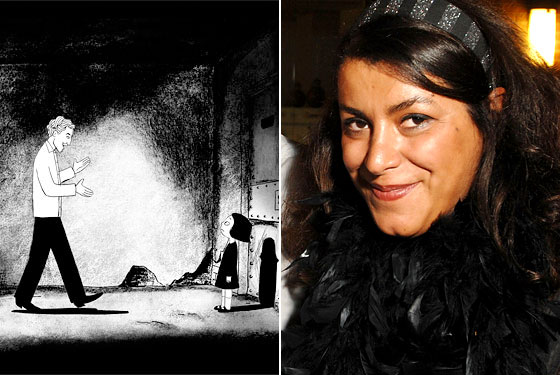Saturday, September 20, 2014
Introduction to Marjane Satrapi
Marjane Satrapi was born in Iran in 1969 and lived through some of the most difficult years of the nation's history. Satrapi's family was a politically-active one with members critical of both the Shah of Iran and the Islamic regime that came to replace him. In Persepolis, Satrapi tells the story of her own childhood but also explores the complexities of Iranian history, the politics of imperialism, the strictures of religious fundamentalism, and the possibilities for survival in exile.
Like Maus, Marjane Satrapi's graphic narrative, Persepolis, is a memoir that marries text and image to tell a story of historical and personal rupture. Persepolis tells the story of Satrapi's childhood experiences during the time of the Islamic Revolution in Iran and her later exile from her homeland. How is Satrapi's story different from the usual coming-of-age narratives we are used to reading in novels and short stories? How does the visual aspect of Persepolis allow Satrapi to show/ not show the graphic violence perpetrated during the bloody revolts and warfare that took place in Iran during the time she was growing up? Persepolis has recently been made into a film. Is Persepolis the graphic narrative already somehow cinematic?
Subscribe to:
Post Comments (Atom)

Unlike other coming-of-age stories we are seeing a story that is showing a nation and its people in a different light than how we originally viewed them. We are often mistaken or hold stereotypes to be true about certain nations and Iran is one of them. The greatest interest is that we are seeing this nation and its people through the eyes and experiences of a young woman that lived it.
ReplyDeleteIn a normal novel the author must used a series of words in order to describe something that others cannot see, while with Satrapi's story we can see some representations of those events, allowing the readers to get a better idea of what she saw and knew but words failed to describe.
The frame by frame images does allow the story to read in a very cinematic manner. There are very few images where the frame is broken. So far in the story the reader can get the feel for the violence without actually showing the images of people being hurt or killed. The author does this very well with the images in the first few pages of the children acting out while not understanding why they had to wear veils. One child choked another while saying, 'execution in the name of freedom.' This isn't the only image with children acting out the violence that they saw. The seriousness of the violence and the extent of how bad it all was could easily been see by watching the children. Children are not able to lie or be deceitful in the same way that adults can be, so they re-enacted what they saw to be normal.
The biggest difference between Satrapi’s coming of age story and those seen in novels and short stories is that Satrapi’s coming of age was very political. Her parents were highly political people and thought it was best for her to be taught the different complexities of the political world especially in their country which has a long history of political strife. The typical coming of age story involves the character coming to terms to their limitations, with the idea that their world is not so perfect after all, or learning how to cope with the loss of a parent(s). Satrapi’s story has the same elements but with the inclusion of very real brutality of war and learning to deal with complex emotions that war brings about that cannot be captured as realistically in fiction.
ReplyDeleteThe visual aspect does not allow for a lot of blood it uses its style in a way that the reader understands just how violent the world was at that time in Iran. Panels such as those on 40 which showed just as much violence than if they had been truly graphic: How many died during massacres; the middle panel 51 showing just how brutally and degradingly people were tortured; on 89 with the visual of people feeling areas that experienced the fire of missiles; and 102 with the image of many unidentified poor children being used like ragdoll across minefields. Visuals don’t have to gratuitously gory for them to get across how much others had suffered.
The way panels and the like are experimented with has a lot of cinematic feel similar to how images will be edited together to shows multiple scenes at one time. It’s not hard to see how it could be easily translated into a movie.
As a student with a creative writing minor, I have read many stories with a coming of age gimmick to them. This one stands out from the others because this is involved with politics. The entire book so far revolves around politics, even her parents talk nonstop about politics. This create a one-world-vision that separates the story from regular stories because they are usually set with multiple worlds based on different views and methods. This story is very powerful and inspirational. Even it's panel are set up well enough to feel like a cinematic. I think it would make a great one, however given Hollywood's reputation on creating movies from book leaves me in doubt.
ReplyDelete